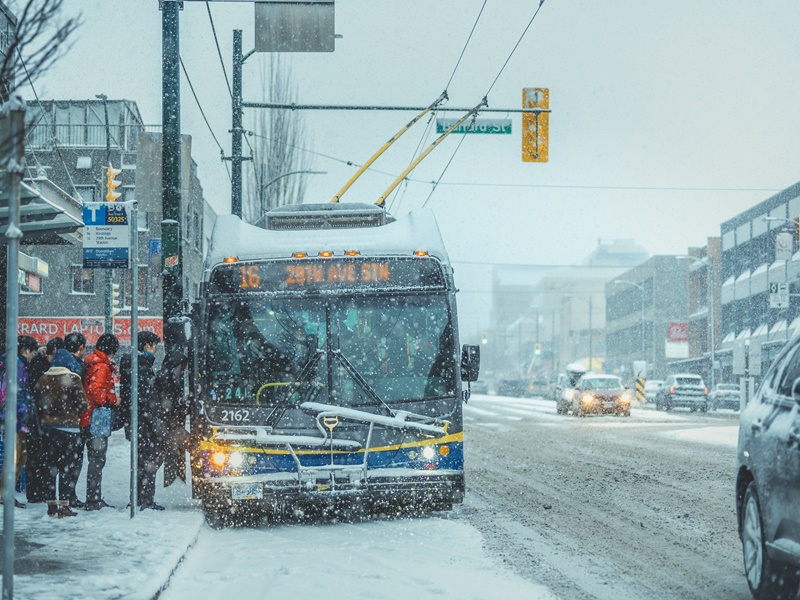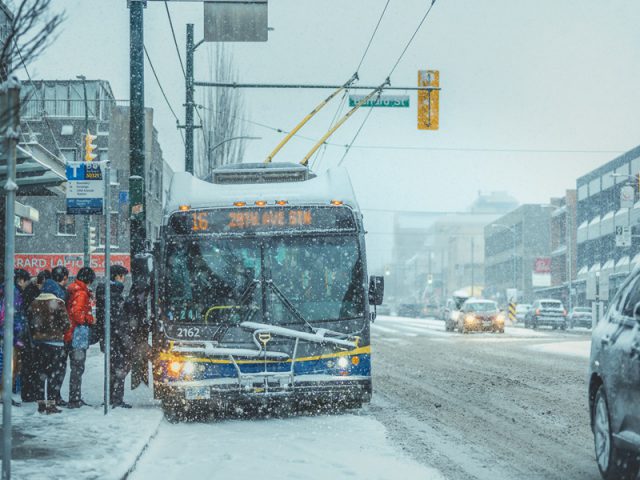TransLink releases details of Winter Plan 2019/20
TransLink releases details of Winter Plan 2019/20


TransLink is releasing details of new initiatives and improvements to prepare for any adverse weather events this winter. This comes amid the launch of a new winter marketing campaign aimed at promoting safety for transit users this season.
“Our initiatives this winter are focused on increasing safety and customer communication at stations, bus exchanges, and throughout our online channels,” says TransLink CEO Kevin Desmond. “We’ve learned from previous seasons and have been working hard to ensure customers are kept informed of any significant delays or issues on our system.”
Last month, TransLink also hosted a meeting between Metro Vancouver municipalities to share and discuss winter preparedness plans. These regional partnerships are crucial to ensuring that any issues can be swiftly dealt with, in order to limit the impact on transit and transportation.
Communications
- *NEW* Station upgrades – Electronic display screens and speakers have been installed and upgraded at many station locations, providing customers with crucial information during delays or weather events.
- *NEW* Touchscreen transit kiosks – TransLink’s touchscreen transit kiosks being deployed around the network can provide full screen warnings when emergencies or significant delays occur.
SkyTrain
- *NEW* Millennium Line coupling – During heavy snowfall, trains on the Millennium Line will be coupled together (4-car trains) to maximize capacity while SkyTrain Attendants monitor guideways.
- *NEW* Canada Line de-icing – Canada Line has upgraded de-icing products being used to keep guideway power rails free of ice.
- SkyTrain guideway monitoring – SkyTrain Attendants will be positioned at the front of trains during heavy snowfall. This initiative improves reliability on the system by limiting emergency braking, which can be triggered by heavy snowfall.
- Canada Line heat tracing – Heat tracing has been installed on the power rail in sections where heavy ice buildup has previously resulted in service disruptions.
- SkyTrain de-icing – De-icer trains will keep power rails free of ice. During times of overnight snow, some trains will run throughout the night to keep tracks clear.
- Problem tree and branch removal – Problem trees and branches situated within 10 metres of SkyTrain tracks are being removed.
Bus
- *NEW* Tire sock improvements – Tire sock sizing is being adjusted this year which will see the socks last for double the distance, with the same level of effectiveness. Tire socks will again be made available for use on Burnaby Mountain and the North Shore.
- *NEW* Snow Desk – There will be a designated Snow Desk in the Transit Communications Centre to monitor bus routes and road conditions.
- *NEW* Snow monitoring – Contractors who plow and shovel at bus loops / exchanges and SkyTrain stations will be encouraged to upload photos for verification of snow conditions.
- Trolley bus wires anti-icing trucks – Trucks will spray de-icing fluid around the entire 300-km electric trolley overhead system when there’s frost or ice risk.
- Additional bus tire traction – Bus Operators can use a snow switch which gives bus tires better traction in snow.
- Bus switch outs – Articulated buses can be switched for conventional buses. 40-foot conventional buses carry fewer passengers, but have better traction in snow, especially on steep terrain.
- Snow routes – Work with municipalities to coordinate our service with priority corridors for snow clearing, should conditions become severe.
HandyDART
- *NEW* Road condition checks – A formal process has been implemented to assess road conditions for customer pickup.
- *NEW* Partner communication strategy – If service disruptions or schedule changes occur, there’s now a strategy in place to notify day programs and health partners of these changes.
- Targeting difficult locations – Customers who can be difficult to access during winter are being contacted early to discuss a clearing plan.
- Extra staffing – If there is a reduction to service, each bus will have two drivers to help customers load and unload.






Just wondering if you are planning to cut down all the tall evergreen trees along the Expo Line? Seems they are being clear cut with little in the way of just thinning or focusing on potential trouble trees. Any plans to replace them for residents along the line who have depended on these trees for sound reduction and a bit of green space in contrast to the industrial appearance of the chain link fence and cars whizzing by? Thank you..
Jan 12, 2020
Hi ,
Just wondering with the snow
conditions were experiencing
and will continue
Will this effect busses being
late as sometimes it does
❄
I take the bus daily to work and back home. Not far to go either. So I really do not have anything to complain about.
I was late for my 2nd day of work because the bus was 1/2 hour late. Then there were 3 buses in a row. It was not snow like we woke up to this morning. I saw bus after bus going the other direction. I just want to know what happened? Were you not prepared like you thought you would be?